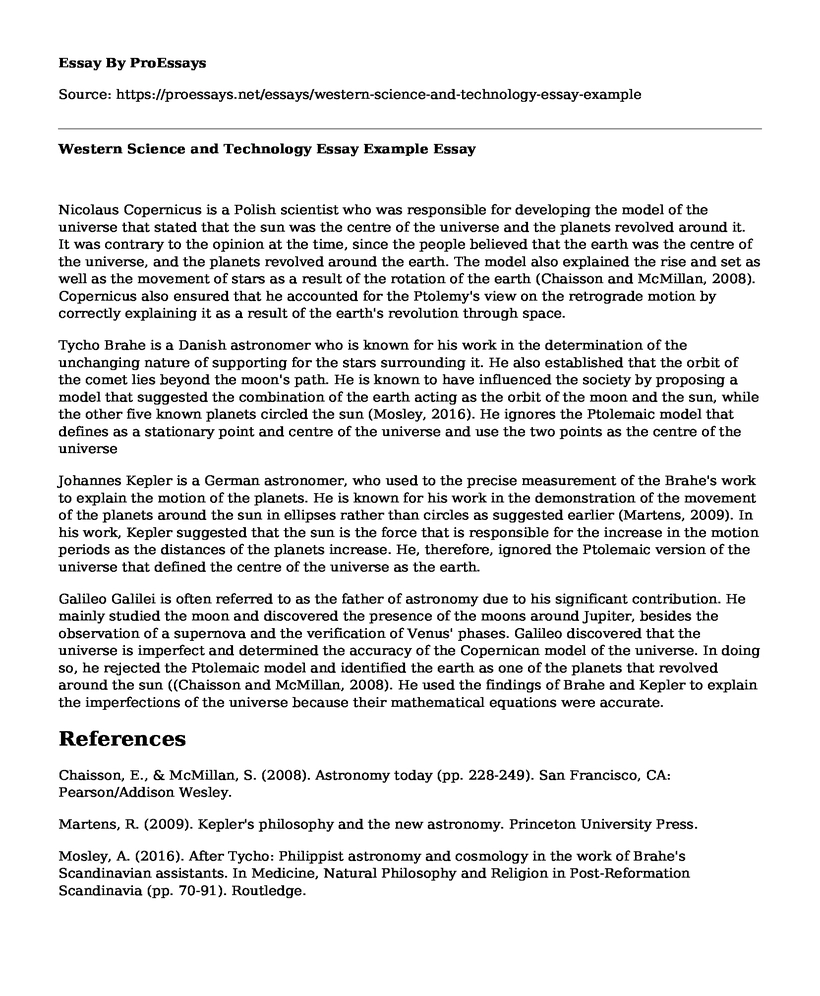Nicolaus Copernicus is a Polish scientist who was responsible for developing the model of the universe that stated that the sun was the centre of the universe and the planets revolved around it. It was contrary to the opinion at the time, since the people believed that the earth was the centre of the universe, and the planets revolved around the earth. The model also explained the rise and set as well as the movement of stars as a result of the rotation of the earth (Chaisson and McMillan, 2008). Copernicus also ensured that he accounted for the Ptolemy's view on the retrograde motion by correctly explaining it as a result of the earth's revolution through space.
Tycho Brahe is a Danish astronomer who is known for his work in the determination of the unchanging nature of supporting for the stars surrounding it. He also established that the orbit of the comet lies beyond the moon's path. He is known to have influenced the society by proposing a model that suggested the combination of the earth acting as the orbit of the moon and the sun, while the other five known planets circled the sun (Mosley, 2016). He ignores the Ptolemaic model that defines as a stationary point and centre of the universe and use the two points as the centre of the universe
Johannes Kepler is a German astronomer, who used to the precise measurement of the Brahe's work to explain the motion of the planets. He is known for his work in the demonstration of the movement of the planets around the sun in ellipses rather than circles as suggested earlier (Martens, 2009). In his work, Kepler suggested that the sun is the force that is responsible for the increase in the motion periods as the distances of the planets increase. He, therefore, ignored the Ptolemaic version of the universe that defined the centre of the universe as the earth.
Galileo Galilei is often referred to as the father of astronomy due to his significant contribution. He mainly studied the moon and discovered the presence of the moons around Jupiter, besides the observation of a supernova and the verification of Venus' phases. Galileo discovered that the universe is imperfect and determined the accuracy of the Copernican model of the universe. In doing so, he rejected the Ptolemaic model and identified the earth as one of the planets that revolved around the sun ((Chaisson and McMillan, 2008). He used the findings of Brahe and Kepler to explain the imperfections of the universe because their mathematical equations were accurate.
References
Chaisson, E., & McMillan, S. (2008). Astronomy today (pp. 228-249). San Francisco, CA: Pearson/Addison Wesley.
Martens, R. (2009). Kepler's philosophy and the new astronomy. Princeton University Press.
Mosley, A. (2016). After Tycho: Philippist astronomy and cosmology in the work of Brahe's Scandinavian assistants. In Medicine, Natural Philosophy and Religion in Post-Reformation Scandinavia (pp. 70-91). Routledge.
Cite this page
Western Science and Technology Essay Example. (2022, Nov 06). Retrieved from https://proessays.net/essays/western-science-and-technology-essay-example
If you are the original author of this essay and no longer wish to have it published on the ProEssays website, please click below to request its removal:
- Personal Statement Example: Designing and Developing a Three Phase Electrical System
- PR Writing Reflection: Facebook Inc. Release on Private Data Breach
- Research Paper on Isotopic Approaches in Global Change Ecology
- Essay Example on Smart Home Security: Automated Intelligence for Home Protection
- Ban Cell Phones While Driving: A Necessity Nationwide - Essay Sample
- Essay Example on Facial Recognition: Verifying Identity with Biometric Data
- Essay Example on Virtual Police Dept. Mobilizes to Stop Notorious VBBC Gang







